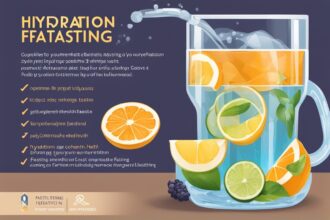Hey there, fasting enthusiasts! If you’re diving into the world of fasting—whether it’s intermittent fasting, water fasting, or a religious fast like Ramadan—you’ve probably wondered how to keep your body hydrated without breaking your fast. Hydration during fasting is a critical piece of the puzzle, often overlooked by beginners. In this fasting guide, I’ll walk you through why staying hydrated matters, how to do it right, and what science says about balancing fluids during a fast. Let’s unpack this together with practical tips and evidence-based insights to help you fast safely and effectively.
Why Hydration Matters During Fasting
When you’re fasting, your body isn’t just skipping meals—it’s entering a unique metabolic state where hydration becomes even more crucial. Normally, about 20–30% of our daily water intake comes from food (Institute of Medicine, 2005). Without that, you’re relying solely on what you drink, which can quickly lead to dehydration if you’re not mindful. Dehydration during fasting can cause fatigue, headaches, dizziness, and even more severe issues like electrolyte imbalances if left unchecked (Popkin et al., 2010). So, in this fasting guide, let’s prioritize hydration as a non-negotiable for your health and fasting success.
Understanding Your Body’s Water Needs While Fasting
Our bodies are roughly 60% water, and every system—from digestion to temperature regulation—depends on it. During fasting, you might notice increased thirst, especially in longer fasts, as your body taps into stored energy and water is released from glycogen stores in the liver and muscles. However, this internal water source isn’t enough to sustain you long-term (Sawka et al., 2007). The average adult needs about 2–3 liters of water daily, though this varies based on weight, climate, and activity level. A solid fasting hydration plan means calculating your baseline needs and adjusting for fasting-specific factors like reduced food-derived water.
How to Stay Hydrated Without Breaking Your Fast
One of the biggest questions in any fasting guide for beginners is: “What can I drink without breaking my fast?” The good news is that water—plain, sparkling, or infused with a slice of lemon—is your best friend. But there are other options too, as long as they’re calorie-free and don’t trigger an insulin response. Let’s break down some practical ways to keep those fluids up without compromising your fasting goals.
- Stick to Water: Aim for at least 8–10 glasses (about 2–2.5 liters) spread throughout your fasting window. Sip regularly rather than chugging all at once to avoid stomach discomfort.
- Try Herbal Teas: Unsweetened herbal teas like chamomile or peppermint are hydrating and can add variety. Avoid sweetened or fruit-flavored teas that might contain hidden sugars.
- Black Coffee in Moderation: If you’re an intermittent faster, black coffee (no cream or sugar) can be okay, but limit it as caffeine can dehydrate you (Killer et al., 2014).
- Electrolyte Water (Carefully): If you’re on a prolonged fast, consider adding a pinch of salt to your water or using a sugar-free electrolyte powder to maintain sodium and potassium levels.
Timing Your Hydration for Optimal Results
Timing is everything when it comes to hydration during fasting. If you’re following a 16:8 intermittent fasting plan, for instance, you’ve got an 8-hour eating window to load up on fluids alongside meals, and a 16-hour fasting window where you’ll need to be strategic. For longer fasts or during hot weather, dehydration risks spike, so planning is key. Studies suggest that consistent small sips throughout the day prevent dehydration better than infrequent large intakes (Pross et al., 2014). In this ultimate fasting guide, I recommend setting reminders to drink every couple of hours during your fasting window and prioritizing hydration right after breaking your fast.
Signs of Dehydration to Watch Out For
Even with the best fasting tips and tricks, it’s easy to miss early dehydration signs when you’re focused on sticking to your fast. Your body will give you clues if it’s running low on fluids, and ignoring them can derail your progress or harm your health. According to the Mayo Clinic (2019), mild dehydration can escalate quickly if not addressed. Keep an eye out for these red flags and act fast if you notice them.
- Thirst and Dry Mouth: This is your body’s first SOS signal. Don’t ignore it—grab some water even if you’re in a fasting window.
- Dark Urine: If your urine is dark yellow or amber, you’re likely dehydrated. Aim for pale yellow as a sign of good hydration.
- Fatigue or Dizziness: Feeling sluggish or lightheaded during fasting often points to low fluid or electrolyte levels.
- Headaches: Dehydration can trigger headaches or migraines, especially during longer fasts.
- Muscle Cramps: A lack of water and electrolytes like sodium or potassium can cause painful cramps, a sign to rehydrate with care.
Electrolytes and Fasting: A Balancing Act
Water isn’t the only player in hydration—electrolytes like sodium, potassium, and magnesium are just as vital, especially during extended fasts. When you fast, your body flushes out more electrolytes through urine, particularly in the first few days as insulin levels drop (Vollmer et al., 2014). This can lead to symptoms like fatigue or heart palpitations if not managed. A smart fasting hydration strategy includes maintaining electrolyte balance without breaking your fast. A pinch of Himalayan salt in your water or a zero-calorie electrolyte drink can help, but don’t overdo it—too much sodium can cause bloating or other issues. Always listen to your body and consult a healthcare provider if you’re unsure.
Let’s wrap this up with a personal note: when I started fasting, I underestimated hydration and paid the price with headaches and irritability. Once I made it a priority—carrying a water bottle everywhere and setting phone alarms to sip—I noticed a huge difference in my energy and focus. Hydration isn’t just about surviving your fast; it’s about thriving through it. Whether you’re a newbie or a seasoned faster, use this fasting guide to build a hydration habit that supports your goals. Remember, fasting is a journey, and keeping your body fueled with fluids is the foundation of a safe and sustainable practice. Stay hydrated, stay strong, and let’s keep learning together!
References
- Institute of Medicine. (2005). Dietary Reference Intakes for Water, Potassium, Sodium, Chloride, and Sulfate. National Academies Press.
- Killer, S. C., Blannin, A. K., & Jeukendrup, A. E. (2014). No evidence of dehydration with moderate daily coffee intake: A counterbalanced cross-over study in a free-living population. PLoS ONE, 9(1), e84154. https://doi.org/10.1371/journal.pone.0084154
- Mayo Clinic. (2019). Dehydration: Symptoms and causes. Retrieved from https://www.mayoclinic.org/diseases-conditions/dehydration/symptoms-causes/syc-20354086
- Popkin, B. M., D’Anci, K. E., & Rosenberg, I. H. (2010). Water, hydration, and health. Nutrition Reviews, 68(8), 439–458. https://doi.org/10.1111/j.1753-4887.2010.00304.x
- Pross, N., Demazières, A., Girard, N., Barnouin, R., Metzger, D., Klein, A., … & Guelinckx, I. (2014). Effects of changes in water intake on mood of high and low drinkers. PLoS ONE, 9(4), e94754. https://doi.org/10.1371/journal.pone.0094754
- Sawka, M. N., Burke, L. M., Eichner, E. R., Maughan, R. J., Montain, S. J., & Stachenfeld, N. S. (2007). American College of Sports Medicine position stand: Exercise and fluid replacement. Medicine & Science in Sports & Exercise, 39(2), 377–390. https://doi.org/10.1249/mss.0b013e31802ca597






